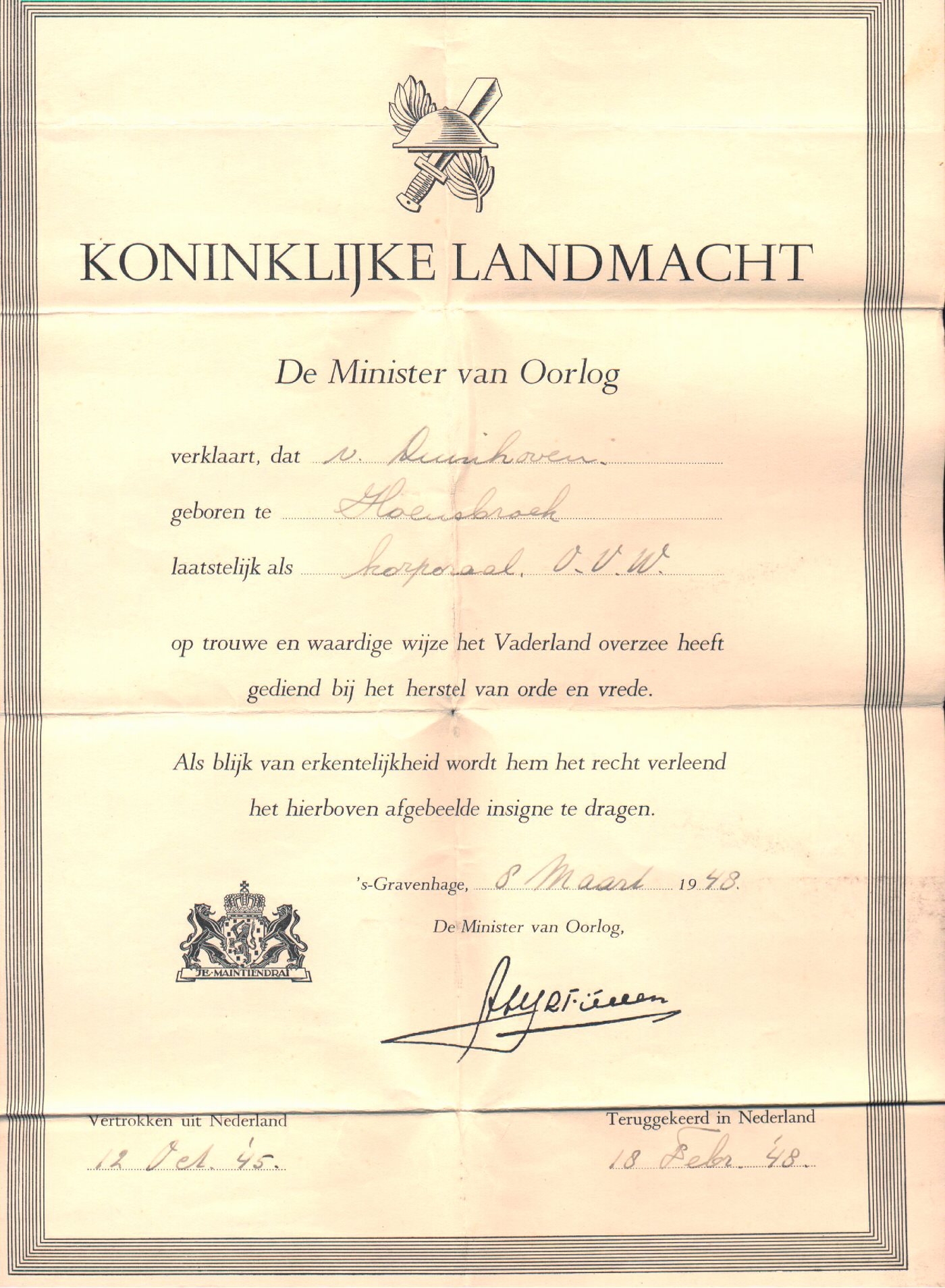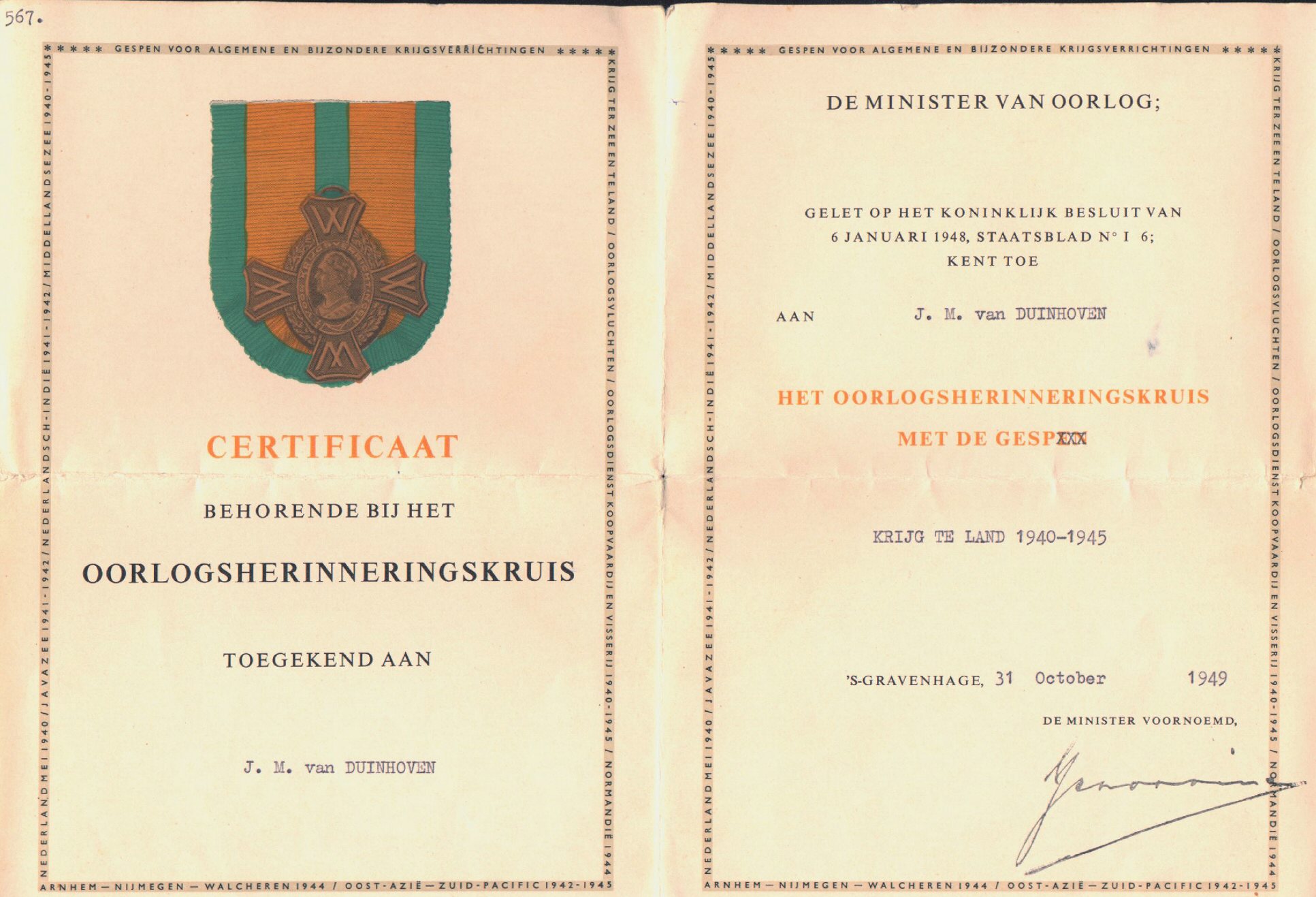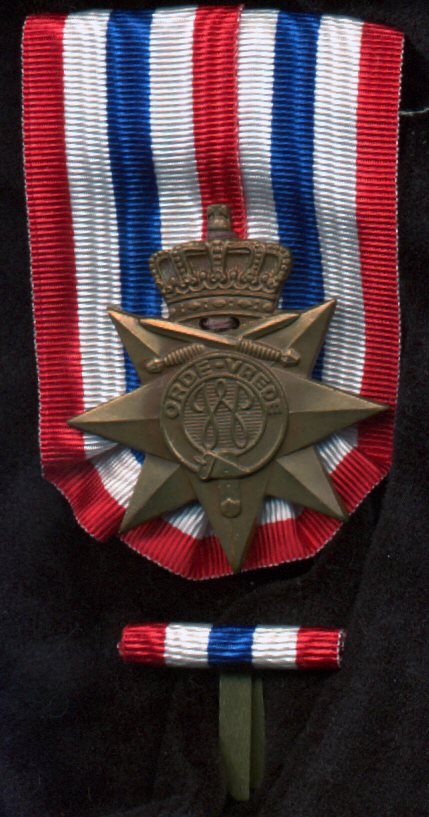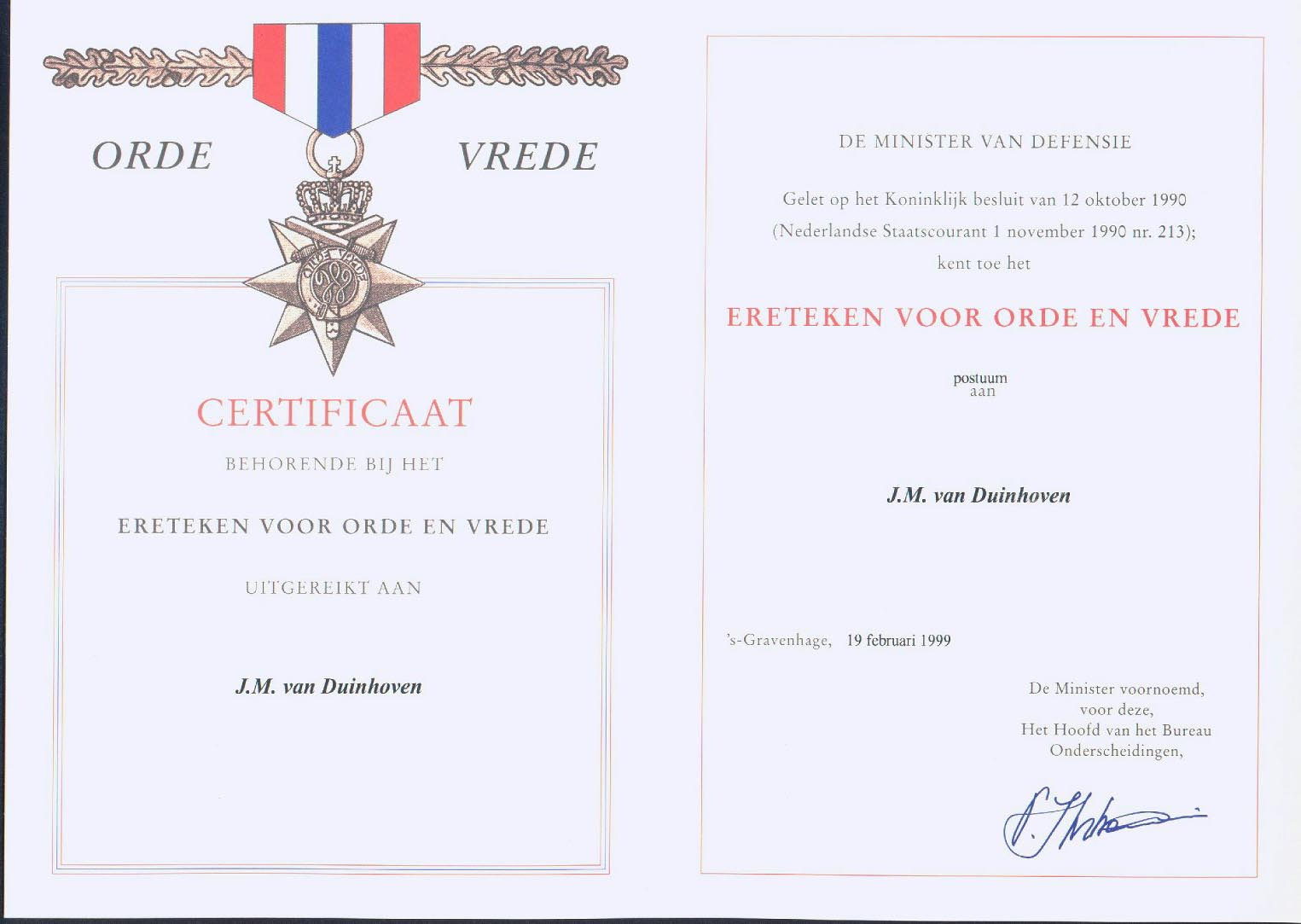"THE COMMEMORATIVE WAR CROSS" (oorlogs-herinneringskruis) with the clasp "KRIJG te LAND 1940-1945" was awarded to my daddy for bravery from the Queen of the Netherlands, Queen Wilhelmina (grandmother of the current Queen). Below that the small ribbon with the metal piece that looks like a rose is called a Baton and it is the undress ribbon bar for the medal. Each bronze star(up to a maximum of 4)on the Baton represents a clasp. When in uniform and at work it would have been cumbersome for soldiers to wear their full medals. It was decided that a small piece of ribbon identifying the full-size medal entitlement would be worn on the uniform instead. the baton on a pin is representative of the full-size medal and the bronze star on the ribbon represents my dad's receipt and award of the "Krig de Land" clasp on the medal.
Directly after the liberation of the southern part of the Netherlands my dad gave himself up as volunteer to the Inland Forces (the Dutch Underground) which later became the Stoottroepen. These volunteer groups of very young Dutch men were added to the Allied Army, 9th US Army and fought together with them against the German army in the first line -- daily bombing and shooting-- and later in Germany to help liberate POWs from Buchenwald and some other camps.
After the capitulation of Germany, the end of the war, many of these young Stoottroepers volunteered as part of the Dutch army to liberate the people of Indonesia from the Sukarno (Indonesian) guerrillas and some Japanese soldiers who were holding many civilians in interment camps. These young Dutch soldiers were the first to experience a jungle war of attrition.
After the war the first generation of Stoottroepers received this distinction for their part in WWII.
In the Netherlands medals were given out sparingly and were well and truly earned by the men who received them.
Thanks to "Capt." Vic Marciano I have got the document below translated into English.
|
CERTIFICATE belonging to the War Commemoration Cross awarded to: J.M. van Duinhoven |
THE MINISTER OF WAR
In view of the Royal Decree dated
J.M. van Duinhoven
Warfare on Land 1940-1945
The Hague, 31 October 1949 |
H.M. Queen Wilhelmina did not approve these proposals when they were submitted to her in December 1943. She wanted to maintain the tradtional Expedition Cross (Cross for Important War Actions, 1869, q.v) without the legend "Voor belangrijke Krijgsverrigtingen", but with the existing ribbon, to which new clasps were to be added, as had already been done with "Timor 1942"
By Royal Decree of 16 March, 1944 this War Commemorative Cross with clasps for war-actions (krijgsverrichtingen) was instituted, to be awarded to those who "had served for at least 6 months, since 10 May, 1940, in the armed forces, merchant navy or civilian air-service and had performed well and shown good conduct"
The actual crosses were to be manufactured after the war, but considerable dissatisfaction was then felt with the original design, which was considered to be obsolete.
Her Majesty wanted the tradition of the Expedition Cross to be continued, but finally permitted her effigy to replace that of King Willem III who had, after all, died nearly 60 years earlier.
Designs were made by the sculptor A. Termote (of Gerritsent&Van Kempen)but these were turned down. The final design(of 2) by Koninklijke Begeer, Voorschoten was accepted by Decree of 10 June, 1947:
It is a cross paty with rounded ended, 40mm and of bronze. The oval medallion in the centre has on the obverse: the effigy of Queen Wilhelmina, facing left, surrounded by a garter with the legend "Voor krijgsverrichtingen". Between the arms, surrounding the medallion, a wreath of oak-leaves;on each arm a "W".
Reverse:plain
Ribbon: 27 mm, orange with green borders(in U-shaped style 40 mm)
Bronze stars with a maximum of 4 on the baton indicate clasps. Crosses were actually handed out between June, 1948 and March 1949. A Decree of 2 November, 1967 put an end to further applications for the cross after 31 December, 1967.
The clasp with one star represents Krijg te land 1940-1945 (actions on land) 6 months of active service in army units. Includes presence on board troop-transports in active war-zones, after June1st, 1940.
CROSS FOR ORDER AND PEACE
I received this letter with the medal and certificate.
Some time ago you submitted a request to me regarding the posthumous award of the Medal for Order and Peace to your father, Mr. J.M. van Duinhoven, date of birth 26 January 1920, in connection with his service in the former Netherlands Indies.
An inquire has shown that your late father was indeed eligible for this award.
I am pleased to inform you that, as a mark of respect and appreciation for his efforts in exceptionally difficult circumstances, the Medal for Order and Peace is herewith awarded posthumously.
Yours sincerely,
HEAD, HONOURS AND AWARDS SECTION
P.V.E. Horbowiec
for The Minister of Defense
|
Order Peace
CERTIFICATE belonging to the Cross for Order and Peace presented to: J.M. van Duinhoven |
THE MINISTER OF WAR
In view of the Royal Decree dated 12 October 1990
J.M. van Duinhoven
J.M. van Duinhoven
The Hague, 19 February 1999 |
This is the period in which several "police actions" took place, i.e. operations against the Indonesian nationalist forces. In December 1949 Indonesian independence was recognized and all troops were withdrawn and disbanded.
The decoration is a bronze star with eight points, 41 mm across.
The topmost point is replaced by two crossed swords, surmounted by a Royal Crown.
The obverse centre shows a stylized W, surrounded by a garter with the legend: "Orde-Verde" (Order,Peace).
The reverse is plain, with a manufacturer's mark (Kon.Begeer)
The ribbon has five equal stripes red/white/blue/white/red (27 mm, court-mounted 28 mm wide).
Number awarded: about 100,000

The Minister of War
declares that
van Duinhoven, born at Hoensbroek,
lastly in the rank of a Corporal Volunteer,
has served the Fatherland overseas
in a faithful and dignified way
to restore order and peace.
As a token of gratitude he is entitled
to wear the badge depicted here above,
The Hague March 8th, 1948
The Minister of War.
Translation Experts Ltd. is pleased to provide this link to the InterTran (tm) multi-language translation system for webpages and text. The translations are not perfect but they can give you a general idea of what is being communicated. Some of the languages have more limited lexicons then others so the quality of translation can vary between the languages. We always suggest that if you need critical translations hire a translators or take the time to learn the language that they want to communicate in. Any text or webpages that are translated will appear within this webpage frame. Some of the languages will need additonal support for specific fonts.



